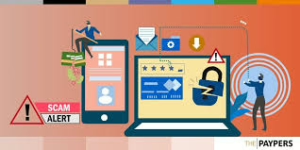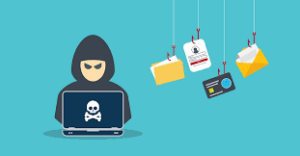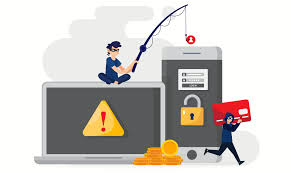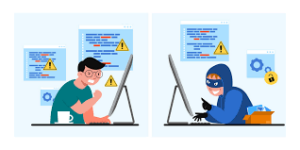Exercise caution, as scammers can exploit banking fraud to empty your accounts and put you in a difficult situation. Recognising various scam tactics makes you a more challenging target to hit. Safeguard your finances by understanding how to detect these attacks and utilising a bank account and credit monitoring service.

Bank scams generally aim to steal either money or sensitive financial data. If an online attacker succeeds, recovering the lost funds can be challenging, if not impossible. The duration of recovery from such financial deceit largely hinges on how promptly you notice the issue, whether law enforcement apprehends the perpetrator, and whether your bank is able to reverse the fraudulent transactions.
In this article, we will guide you on how to recognise scams, offer advice on shielding your assets from fraudsters, and outline your options should you become a victim of a banking scam.
How do bank scams operate?
The term “bank scams” encompasses a variety of specific schemes that can manifest in numerous ways. However, the underlying mechanics of these scams remain consistent. In every instance, a hacker will:
- Identify a target: Scammers typically focus on individuals with substantial wealth or those who seem particularly susceptible. In some cases, they may launch widespread attacks to ensnare anyone who falls for their deceptive tactics or malicious links.
- Investigate the target: For victims with a prominent online presence, attackers may leverage publicly available information to conduct social engineering. They might also employ phishing, malware, or fake websites to obtain login credentials for bank accounts.
- Defraud the target: Once the attacker gains access to the victim’s bank account, they can deplete linked accounts. Some may opt for a slower approach, gradually siphoning off funds over time.
Additionally, the approach to bank scams can vary based on their specific type.
Five Common Bank Scams to Watch For
As online banking grows increasingly popular, fraudsters are becoming more inventive in their approaches. Here are five prevalent bank scams you need to be aware of:
- Advance-fee Fraud
In an advance-fee fraud scheme, a perpetrator deceives their victim into making a payment upfront—often as a deposit—before delivering a product or providing a service. While this scam doesn’t involve hacking into bank accounts, it frequently uses payment platforms like CashApp and Zelle to take advantage of individuals and jeopardise their financial security.
To spot advance-fee fraud, Be cautious of unsolicited offers for services that require an immediate deposit, especially from individuals with little to no online reputation or positive feedback.
To avoid advance-fee fraud, Investigate the seller’s credibility and opt for payment methods that offer buyer protection when making deposits.
- Overpayment Scam Alert
An overpayment scam occurs when a fraudster sends a check that exceeds the correct amount and then asks the recipient to refund the excess. These checks are typically designed to fail when deposited, allowing the scammer to vanish before the bank recognises the issue.
Example of an overpayment scam communication.
How to Spot an Overpayment Scam: Carefully compare the amounts written in both the numerical and written formats to ensure they align with what was agreed upon.

How to Protect Yourself from Overpayment Scams: Whenever possible, collect checks in person, double-check that all details on the check are accurate before leaving, and do not issue any refunds until the check has fully cleared.
- Counterfeit Check Scam
Counterfeit check scams occur when fraudsters attempt to pay for goods or services using fake checks. This scheme enables them to steal items because it may take several days for banks to process and identify the check as fraudulent.
An example of a counterfeit check lacking essential elements that could be used in a banking scam.
How to Identify a Counterfeit Check Scam: Ensure the check is legitimate by looking for a rough edge on one side and looking for common errors such as misspelt words, missing security features, or other inconsistencies.
How to Avoid Counterfeit Check Scams: Avoid counterfeit check fraud. To avoid problems with a check, ask for an alternative payment method or contact the individual’s bank. To confirm that a check is genuine, inspect the account holder’s details located in the upper left corner and ensure that the check includes security elements such as colour-shifting ink, a padlock symbol, and a designated security area.
- Phantom Investment Fraud
Investment frauds typically involve a scammer impersonating a bank official and presenting fake investment options in areas like mutual funds, stocks, bonds, high-yield savings accounts, or certificates of deposit (CDs). Once a bank customer provides funds or inputs their login credentials on a fraudulent website, the scammer can redirect the money to their own account.
Here’s an example of a message related to an investment scam.
Recognising an investment fraud: Always be wary of unsolicited proposals that seem overly beneficial or that use high-pressure tactics to rush you into making a decision.

Preventing investment fraud: Contact your bank using official communication methods to confirm the authenticity of any opportunity. Be cautious of “offers” that suggest there are no risks involved. Ensure financial discussions occur through secure channels, and avoid clicking on dubious links.
- Automated Payment Fraud
Automated payment fraud usually occurs when a scammer has already obtained the victim’s account details. By utilising the account and routing numbers, they can establish automatic withdrawals that gradually extract funds from the victim’s account. If the amount taken is small enough and the account owner fails to scrutinise their bank statements regularly, the fraudster can withdraw a significant sum before being detected.
Here’s an illustration of what a fraudulent withdrawal in an automated payment fraud scenario might resemble.
Recognising Automated Payment Fraud: Check your mobile banking app for any unfamiliar withdrawals. Scammers often use vague descriptions to avoid immediate detection.
Preventing Automated Payment Fraud: Review your bank statements each month and investigate any unfamiliar charges.
How can you identify if someone is attempting to steal from your bank account?
Cybercriminals frequently employ social engineering tactics, such as impersonating a bank representative or investment advisor, to perpetrate bank fraud. Additionally, you may observe various warning signs if they accessed your account using login credentials obtained from the dark web, through brute-force attacks, or via data breaches.
Regardless of the method used to compromise your information, here are some warning signs to be vigilant about:
Uncommon financial requests: A genuine bank representative will never ask you to transfer money or send cryptocurrency for fees or investments.

Unknown transactions: If a hacker gains access to your account, they can exploit your account and routing numbers to make online purchases without your consent.
Unexpected communications and dubious links: If attackers are unable to find your information online, they may resort to sending phishing messages designed to deceive you into disclosing confidential information.
Coercive tactics: While legitimate banks encourage their customers to invest, they won’t pressure you to make decisions without giving you the opportunity to ask questions.
Fraud notifications from your bank: Notifications regarding unauthorised charges or credit applications may indicate that someone else has accessed and is misusing your account.
Five strategies to shield yourself from banking scams
You place trust in your bank, and cybercriminals are aware of this. They exploit the established trust associated with financial institutions to take advantage of you and steal your funds. However, by adopting a proactive stance towards banking security, you can protect your accounts from fraudsters.
Here are five effective methods to secure your accounts:
- Create strong passwords
Use robust and complex passwords for your accounts. This makes it more difficult for hackers to guess your credentials through methods like brute force attacks. Additionally, consider enabling two-factor authentication (2FA) as an extra layer of security, ensuring that even if hackers obtain your login details, they cannot access your bank account.
- Steer clear of unsecured Wi-Fi networks
While it’s common to connect to guest Wi-Fi, it’s wise to refrain from sharing personal details or making purchases while on these networks. Otherwise, hackers might intercept your banking information using techniques such as man-in-the-middle or packet sniffing attacks. If you must use public Wi-Fi, ensure you utilise a mobile VPN to safeguard your connection from potential threats.
- Seek advice from financial experts
Fraudsters may impersonate representatives from your bank, offering fake loans or investment opportunities. If you encounter such an offer, consult with your bank’s advisors to verify its authenticity and gain further insights about the proposal. Stay vigilant against fraudulent texts and email scams, particularly those originating from unverified sources that prompt you to click on links for additional information.
- Obtain mobile banking applications from trusted sources
To prevent spoofing and harmful communications, only download mobile banking apps from your bank’s official website or a reliable app store. Even if your bank sends you messages, it’s wise to switch to the app or another secure method for communication. This practice helps safeguard your financial discussions and reduces the risk of clicking on malicious links.

- Consider identity theft protection services
Investing in identity theft protection is a smart way to safeguard your finances, as it can alert you to suspicious activities before they escalate. Comprehensive services like LifeLock Ultimate Plus provide notifications for bank account withdrawals, balance transfers, and potential takeovers, enabling you to maintain oversight of your financial situation and identify possible threats,
Steps to recover from bank fraud
Dealing with bank scams can be overwhelming, but prompt action is essential to prevent permanent loss of funds. Here’s how to reclaim your account and any stolen money:
Notify your bank: Tell them about the scam so they can monitor your account for fraudulent activities. They will also guide you on how to recover any lost funds.
Freeze compromised accounts: Implement a credit freeze and get a new debit card to block unauthorised transactions.
Change your passwords: Revise your login credentials and PINs to prevent future access by the hacker.
File a police report: Establish a documented record that can enhance your chances of retrieving lost money.
Keep an eye on your bank accounts: In the months following a scam, regularly check your credit score and financial accounts to ensure the hacker doesn’t steal additional funds or create new accounts under your name.
Robust safeguards against banking fraud and identity theft
Regardless of your vigilance, certain dangers may still evade detection. Therefore, it’s essential to protect your online banking with robust identity and data theft safeguards.
LifeLock Ultimate Plus provides exceptional security by keeping an eye on your accounts and identifying risky transactions. Should your money or identity be compromised, you’ll receive expert technical and legal assistance to help you recover. Secure reliable identity protection now.

Common inquiries about banking fraud
Do you still have concerns about bank scams in 2024? Here’s some critical information to consider.
Why was I a victim of a banking scam?
Often, fraudsters do not specifically target individuals; instead, they execute broad phishing campaigns aimed at ensnaring as many victims as possible. However, if you are targeted directly, it is usually due to one of the following reasons:
You maintain a strong social media presence without adequate security measures.
Your account information has been compromised.
Your account information has been compromised due to a data breach.
Cybercriminals suspect that you possess significant wealth or assets.

The scammer harbours a personal grudge against you.
Is it possible for someone to use my identity to commit fraud against others?
Yes, a cybercriminal can impersonate you and engage in financial fraud aimed at others, particularly if you have a professional connection to a banking institution.
How might someone access funds from my bank account?
An individual could either directly take over your account or utilise a card skimmer to steal money. To prevent these incidents, consider the following safety measures:
– Use ATMs located in well-lit, busy areas.
– Shield the ATM’s keypad while entering your PIN.
– Activate transaction notifications.
– Regularly check your bank statements.
– Utilize virtual cards for payments.
– Avoid entering banking information on unsecured networks.
– Implement two-factor authentication for mobile banking platforms and applications.
– Always verify the sender’s identity before clicking on any links.

How can I distinguish between phishing attempts and genuine messages from my bank?
A valid message should:
– Be free of spelling and grammatical mistakes.
– Come from an official email address.
– Address you personally by name.
– Steer clear of urgent requests and unreasonable demands.
Maxthon
Maxthon is poised to revolutionize the cloud gaming experience with its innovative browser, specifically designed with gamers at its core. At its heart lies a sophisticated network of algorithms that enhance speed and performance, elevating gameplay to unprecedented levels. These state-of-the-art technologies work together seamlessly to deliver breathtaking visuals while eliminating any latency that could disrupt the gaming experience. For enthusiasts seeking a deeply immersive experience, this flawless integration is not just an added feature; it is an essential requirement.
However, Maxthon’s appeal goes well beyond iMaxthon’s. The browser employs advanced data management techniques that significantly reduce loading times between different levels and game modes. This impressive improvement allows players to dive straight into the action without the frustration of long waits, ensuring that each thrilling moment of their gaming journey is thoroughly enjoyed.
In addition to its remarkable speed and visual excellence, Maxthon prioritises stable connectivity. Gamers can rely on a consistent connection with minimal interruptions, whether embarking on solo adventures or teaming up with friends for intense online battles. This commitment to maintaining strong connections dramatically enhances the overall gaming experience, allowing players to lose themselves in their virtual realms without disruptions.
One of Maxthon’s standout features is its compatibility across a wide variety of devices. Whether you’re on a smartphone, tablet, or desktop, accessing your favourite games has never been simpler; the days of being tethered to a single console are over. This newfound flexibility brings an exceptional level of convenience to your gaming habits. Imagine coming home after a long day, settling into your favorite chair, and with just a few taps on your device, effortlessly resuming your adventure right where you paused. This illustrates the brilliance of cross-device functionality that Maxthon proudly offers.

